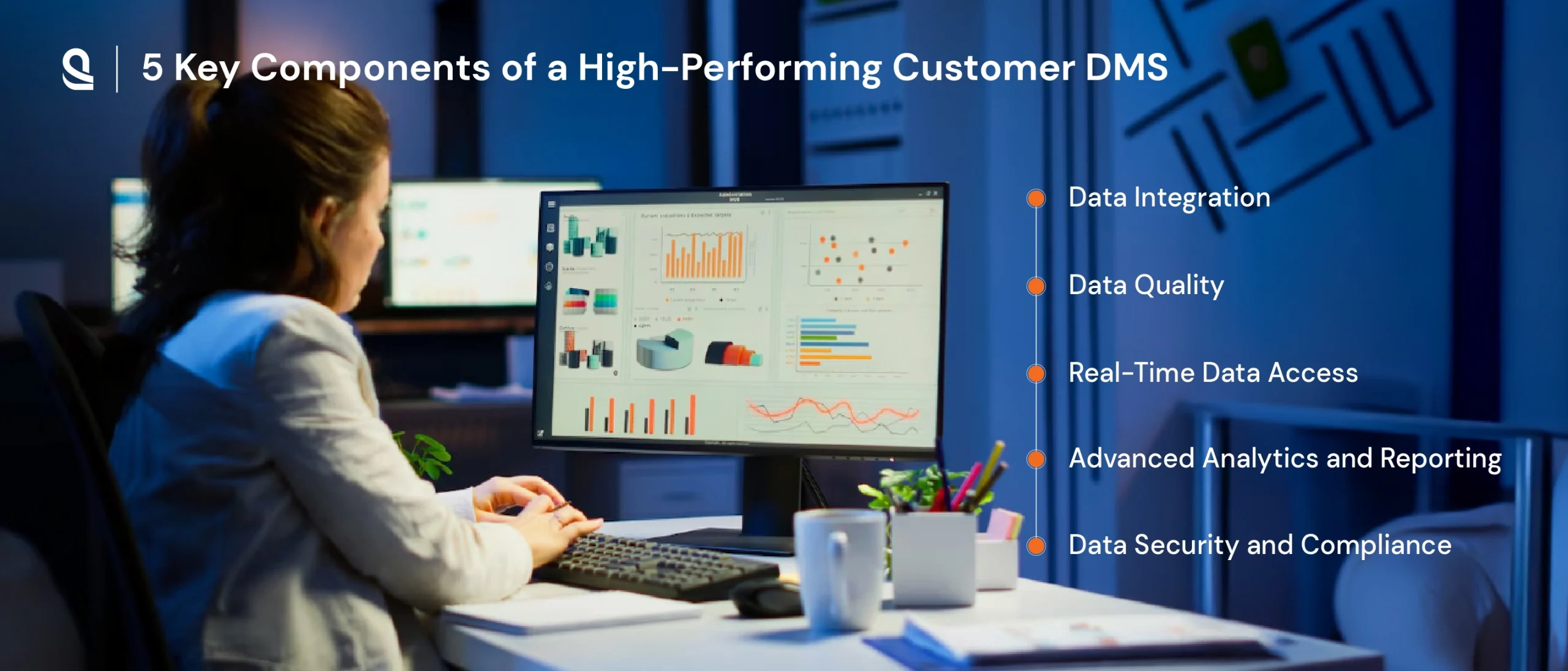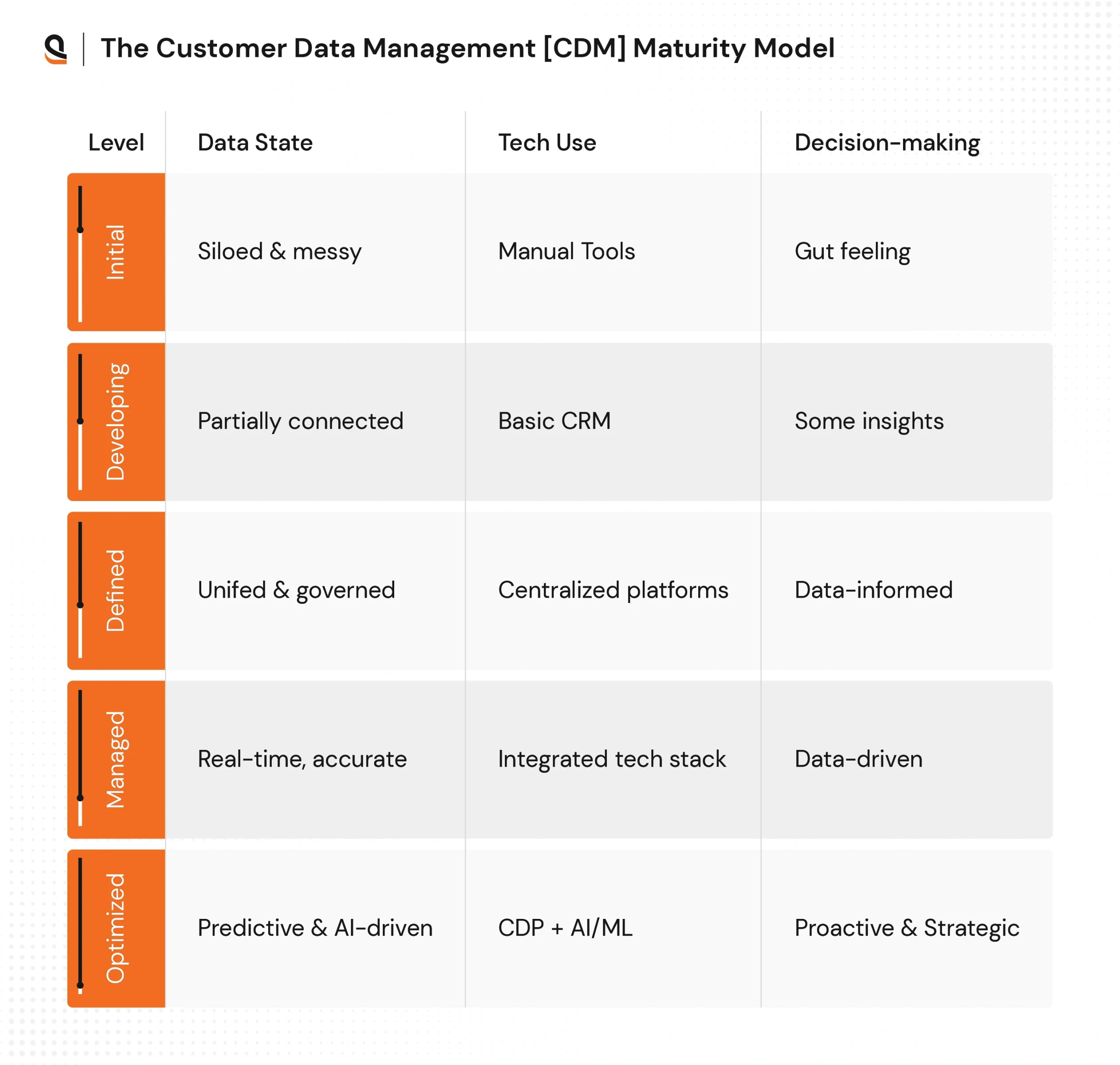Many businesses are sitting on a goldmine of data, but without the right customer data management process, it’s nothing more than clutter. In fact, a staggering 73% of customer data goes underused, leaving massive potential untapped.
So, what’s the secret to turning your data into a powerhouse? It all starts with a high-performing customer data management system. But what makes a system truly high-performing?
Here you will uncover the 9 critical components that will transform your customer data from just information to a strategic asset. Whether you’re wondering what customer data management is or looking for the best customer data management software, mastering these components is the game-changer you need.
Ready to supercharge your data? Let’s dive in!
But First, What Is Customer Data Management?
Have you ever wondered what happens behind the scenes when businesses make data-driven decisions? The secret is customer data management (CDM). But what exactly does it mean, and why should you care?
Customer data management is the process of collecting, organizing, storing, and utilizing customer data in a way that it’s always accessible, accurate, and actionable. This means integrating all customer information from various touchpoints — from email interactions to purchase history — into one unified system. It’s the backbone of personalization, customer insights, and even predictive analytics.
So, why does it matter?
Customer expectations are higher than ever! They demand personalized experiences, real-time responses, and seamless interactions across multiple channels. If businesses don’t have a solid customer data management system in place, they risk falling behind competitors who are leveraging data to enhance their customer experience.
Effective customer data management solutions empower businesses to capture relevant customer information, segment it for targeted campaigns, and optimize every touchpoint along the customer journey. Essentially, it’s the key to creating smarter, more efficient, and more profitable marketing strategies. But how exactly do you turn raw data into actionable insights? That brings us to the next step: understanding how to build a unified customer data management system.
5 Main Components of Effective Customer Data Management System
A high-performing customer data management system is the backbone of a successful customer data strategy. Think of it as the central hub that collects, organizes, and integrates customer information from multiple sources, providing a 360-degree view of each customer. But what makes up this powerful system?
5 Key Components of a High-Performing Customer Data Management System:
1. Data Integration – A seamless integration of data from various sources is the bedrock of an effective customer data management system. Whether it’s from your website, mobile apps, CRM, or social media platforms, integrating all these touchpoints into a unified system creates a single source of truth. This is essential for achieving consistency across different departments and ensuring that all teams are working from the same, up-to-date data set.
2. Data Quality – Data is only as valuable as its quality. Ensuring that your data is accurate, clean, and up-to-date is a fundamental aspect of any high-performing customer data management system. Without regular data cleaning and validation, you risk making decisions based on incomplete or incorrect information. Implementing strong data management solutions to maintain data quality ensures that every insight you extract is reliable and actionable.
3. Real-Time Data Access – In today’s fast-paced environment, businesses must have real-time access to customer data to remain competitive. Real-time insights allow companies to make agile decisions, whether it’s responding to customer inquiries or adjusting marketing campaigns based on current behaviors. A high-performing customer data management system should enable businesses to track and respond to changes in customer interactions as they happen, ensuring timely and relevant actions.
4. Advanced Analytics and Reporting – The real value of your customer data management system lies in its ability to generate actionable insights. Advanced data analytics and reporting tools enable businesses to identify trends, track customer behaviors, and predict future actions. These insights empower teams to personalize marketing campaigns, optimize product offerings, and improve customer service. With the right tools, you can harness data to create smarter strategies that drive engagement and profitability.
5. Data Security and Compliance – Data security isn’t just a “nice-to-have” — it’s a must. As data privacy regulations tighten, ensuring your customer data management system complies with laws like GDPR and CCPA is critical. A high-performing system will not only protect sensitive customer information but also build trust with your audience. Robust encryption, secure data storage, and access controls are all part of maintaining compliance and securing customer data in today’s increasingly regulated environment.
By integrating all of these components, you create a single source of truth that allows your team to access accurate, reliable data in real-time. This unified system will empower your business to deliver highly personalized experiences and make more informed decisions.
The Customer Data Management Process You Need for Maximum Impact
Now that we know what customer data management is and the anatomy of a unified system, let’s dive into the customer data management process. The process involves a series of steps that turn raw data into actionable insights.
Here’s how it works:
1. Data Collection: The first step in the customer data management process is collecting data from every possible source. Whether it’s transactional data, website visits, social media interactions, or customer support queries, every touchpoint is an opportunity to collect valuable insights.
2. Data Centralization: Once the data is collected, it needs to be centralized in a customer data management system. Centralization ensures that all customer data is stored in one location, making it easy to access and manage. A unified system also reduces the risk of data silos, where information is fragmented across different departments.
3. Data Cleaning and Enrichment: The quality of your data is key to the effectiveness of the entire process. Cleaning involves removing duplicate records, fixing inconsistencies, and ensuring data is up to date. Enrichment may involve supplementing your data with third-party information to create more comprehensive customer profiles.
4. Data Analysis and Segmentation: With clean, centralized data in hand, the next step is to analyze and segment it. This allows businesses to understand different customer behaviors, preferences, and pain points. Segmentation makes it possible to deliver personalized experiences, whether through targeted marketing or customized customer support.
5. Actionable Insights and Reporting: Finally, the goal of customer data management is to produce actionable insights that drive business decisions. By leveraging advanced reporting tools and analytics, businesses can track key performance metrics, uncover trends, and optimize marketing strategies.
The customer data management process ensures that every customer interaction is informed by accurate, relevant data, leading to better engagement, retention, and overall success.
Strategic Use Cases of Turning Customer Data Into Business Value
It’s one thing to manage your customer data, but how do you make it truly work for you? By exploring strategic use cases, we’ll show you how to transform your data into actionable insights that drive business growth. These real-world examples will provide the context you need to understand how customer data management can become a game changer for your business.
1. Personalized Marketing Campaigns – Create Marketing That Feels Personal (Because It Is)
Imagine sending emails or showing ads that speak directly to what your customers care about — like recommending a product they’ve been eyeing, or giving them a discount on something they actually want. That’s what personalized marketing is all about. When you use your customer data to really understand people’s preferences and behavior, your marketing goes from “meh” to “wow, that’s exactly what I needed.”
- ⭐ Use your data to segment your audience — think past purchases, browsing habits, or location — and build campaigns that actually resonate.
2. Customer Segmentation: Make Sales Smarter, Not Harder
Not every lead is created equal. But with customer data, you can figure out who’s really ready to buy — and who needs more time. This means your sales team can consume less time guessing and more time closing. By tracking customer behavior and demographics, you can prioritize the right leads and tailor your message to what matters most to them.
- ⭐ Look for signs like repeat site visits, cart additions, or email opens — these are great signals your team can act on.
3. Customer Retention: Build Loyalty with Rewards That Make Sense
Loyalty programs work best when they feel meaningful. By analyzing customer behavior over time, you can create loyalty programs that reward the right people with the right perks, not just generic points. Whether it’s exclusive early access or a discount on their favorite product, your data tells you exactly what keeps customers engaged.
- ⭐ Use past purchase patterns or interaction frequency to shape your loyalty tiers and rewards.
4. Product Development: Plan Ahead with Predictive Insights
Wouldn’t it be nice to know what your customers want before they even ask? That’s where predictive analytics comes in. By looking at trends in your customer data — like what’s selling when, or which products tend to go together — you can make smarter decisions on product development, marketing campaigns, and inventory.
- ⭐ Look for patterns in seasonal trends of your developed product or repeat purchases to guide your strategy.
5. Customer Support Optimization: Streamline What’s Not Working Internally
Customer data doesn’t just help your marketing team — it can seriously improve your internal operations too. For example, if you’re seeing frequent returns on a product, your data might reveal a product flaw or confusing instructions. Or maybe support requests spike after certain emails go out. This kind of insight helps you tighten up processes and fix inefficiencies.
- ⭐ Regularly review support tickets, order history, and feedback loops to spot bottlenecks.
The Customer Data Management [CDM] Maturity Model
As businesses evolve, so do their customer data management systems. The CDM maturity model is a framework used to assess where your organization stands in its data management journey. It outlines different stages, from basic data management practices to advanced, AI-powered systems.
Understanding where you fall within the maturity model can help guide your next steps.
1. Initial: Customer data is fragmented, ungoverned, and unreliable. Teams operate in silos with no standard processes, leading to inconsistent insights and poor customer experiences. → Identify data sources, eliminate silos, and implement a foundational CRM.
2. Developing: Basic systems are in place with partial data integration. Processes are repeatable but manual. Data ownership and initial governance are emerging, improving consistency and collaboration. → Standardize data entry, establish basic governance, and integrate core systems.
3. Defined: A centralized view of customer data exists. Strong governance, standardized processes, and quality controls support reliable, cross-departmental access for aligned decision-making. → Centralize customer data with CDP/MDM and enforce governance policies.
4. Managed: Data flows in real-time across platforms. Advanced analytics enable personalized experiences. Data is strategically leveraged across the organization to drive growth and customer value. → Enable real-time data syncing and use data for personalization and insights.
5. Optimized: AI and predictive models enhance decision-making and customer engagement. Data management is automated, continuously improving, and central to innovation, personalization, and competitive advantage. → Utilize AI/ML for predictive insights and automate personalized customer experiences.
Find Customer Data Management Software That Fits Your Business
The right software doesn’t just store your data — it connects it, organizes it, and helps you use it where it counts. Whether you’re trying to streamline your marketing, improve customer experiences, or make smarter business decisions, the right customer data management solution makes it all possible.
AQe Digital, your digital transformation partner, understands that no two businesses need the exact same thing. That’s why we don’t believe in pushing generic tools. Instead, we help you choose, implement, and scale a customer data management system that actually fits your goals, team, and tech stack.
Here’s how we support you:
Help you define your customer data management process, end to end
- Recommend customer data management software tailored to your industry and needs
- Set up smooth integration with your current platforms (CRM, email, support, etc.)
- Build a central, unified customer data management system that’s easy to use
- Train your team to get the most out of your data — without overwhelm




